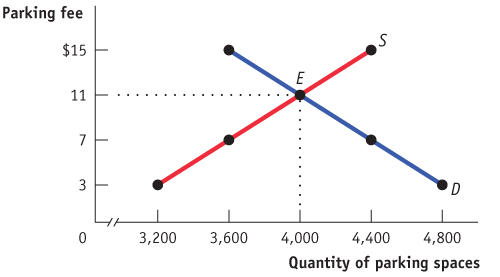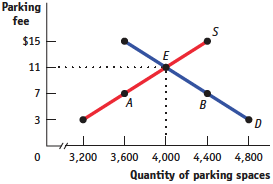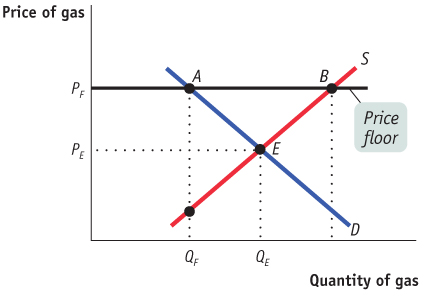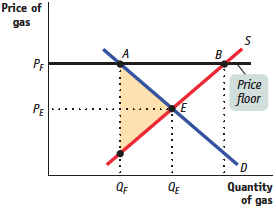Check Your Understanding
Question
On game days, homeowners near Middletown University’s stadium used to rent parking spaces in their driveways to fans at a going rate of $11. A new town ordinance now sets a maximum parking fee of $7. Use the accompanying supply and demand diagram to show how each of the following can result from the price ceiling.

Some homeowners now think it’s not worth the hassle to rent out spaces.
Fewer homeowners are willing to rent out their driveways because the price ceiling has reduced the payment they receive. This is an example of a fall in price leading to a fall in the quantity supplied. It is shown in the accompanying diagram by the movement from point E to point A along the supply curve, a reduction in quantity of 400 parking spaces.
Some fans who used to carpool to the game now drive alone.
The quantity demanded increases by 400 spaces as the price decreases. At a lower price, more fans are willing to drive and rent a parking space. It is shown in the diagram by the movement from point E to point B along the demand curve.Some fans can’t find parking and leave without seeing the game.
Under a price ceiling, the quantity demanded exceeds the quantity supplied; as a result, shortages arise. In this case, there will be a shortage of 800 parking spaces. It is shown by the horizontal distance between points A and B.
Explain how each of the following adverse effects arises from the price ceiling.
Some fans now arrive several hours early to find parking.
Price ceilings result in wasted resources. The additional time fans spend to guarantee a parking space is wasted time.Friends of homeowners near the stadium regularly attend games, even if they aren’t big fans. But some serious fans have given up because of the parking situation.
Price ceilings lead to the inefficient allocation of goods— here, the parking spaces—to consumers. If less serious fans with connections end up with the parking spaces, diehard fans will have no place to park.Some homeowners rent spaces for more than $7 but pretend that the buyers are nonpaying friends or family.
Price ceilings lead to black markets.
Question
True or false? Explain your answer. A price ceiling below the equilibrium price in an otherwise efficient market does the following:
increases quantity supplied
False. By lowering the price that producers receive, a price ceiling leads to a decrease in the quantity supplied.makes some people who want to consume the good worse off
True. A price ceiling leads to a lower quantity supplied than in an efficient, unregulated market. As a result, some people who would have been willing to pay the market price, and so would have gotten the good in an unregulated market, are unable to obtain it when a price ceiling is imposed.makes all producers worse off
True. Those producers who still sell the product now receive less for it and are therefore worse off. Other producers will no longer find it worthwhile to sell the product at all and so will also be made worse off.
Question
The state legislature mandates a price floor for gasoline of PF per gallon. Assess the following statements and illustrate your answer using the figure provided.

Proponents of the law claim it will increase the income of gas station owners. Opponents claim it will hurt gas station owners because they will lose customers.
Some gas station owners will benefit from getting a higher price. QF indicates the sales made by these owners. But some will lose; there are those who make sales at the market equilibrium price of PE but do not make sales at the regulated price of PF . These missed sales are indicated on the graph by the fall in the quantity demanded along the demand curve, from point E to point A.
Proponents claim consumers will be better off because gas stations will provide better service. Opponents claim consumers will be generally worse off because they prefer to buy gas at cheaper prices.
Those who buy gas at the higher price of PF will probably receive better service; this is an example of inefficiently high quality caused by a price floor as gas station owners compete on quality rather than price. But opponents are correct to claim that consumers are generally worse off—those who buy at PF would have been happy to buy at PE, and many who were willing to buy at a price between PE and PF are now unwilling to buy. This is indicated on the graph by the fall in the quantity demanded along the demand curve, from point E to point A.Proponents claim that they are helping gas station owners without hurting anyone else. Opponents claim that consumers are hurt and will end up doing things like buying gas in a nearby state or on the black market.
Proponents are wrong because consumers and some gas station owners are hurt by the price floor, which creates “missed opportunities”— desirable transactions between consumers and station owners that never take place. The deadweight loss, the net gains forgone because of missed opportunities, is indicated by the shaded area in the accompanying figure. Moreover, the inefficiency of wasted resources arises as consumers spend time and money driving to other states. The price floor also tempts people to engage in black market activity. With the price floor, only QF units are sold. But at prices between PE and PF , there are drivers who together want to buy more than QF and owners who are willing to sell to them, a situation likely to lead to illegal activity.